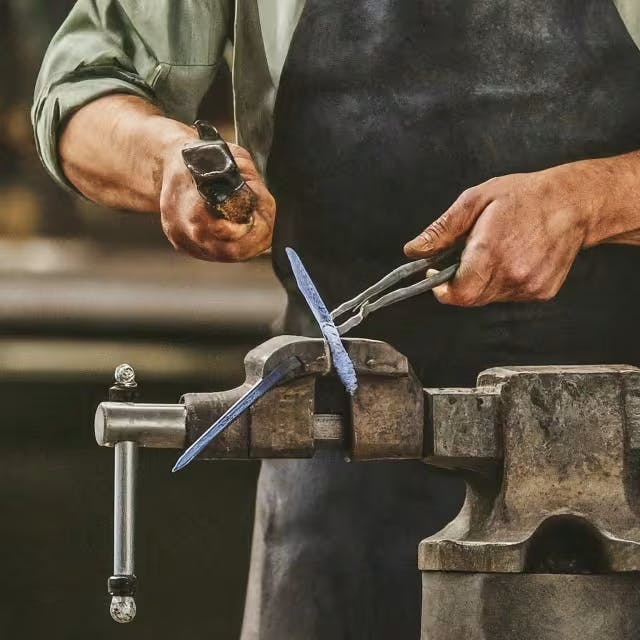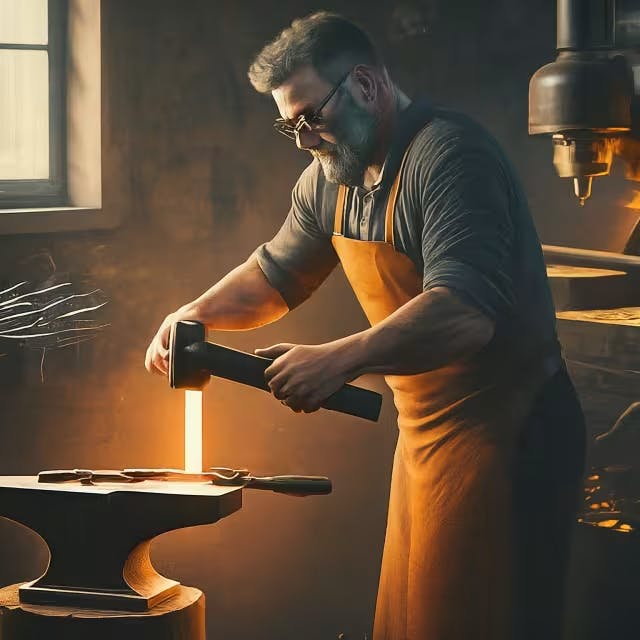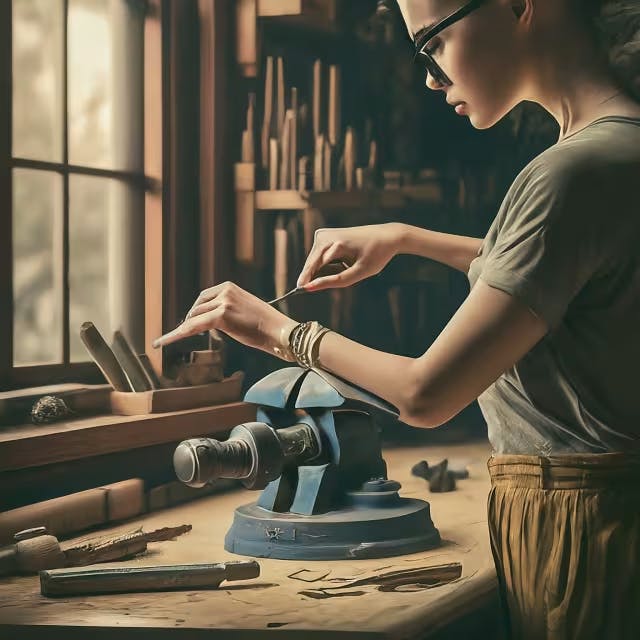Blacksmith Leg Vises: A Comprehensive Guide
Abana Chapter
February 28, 2024

Diving into the world of blacksmithing reveals the indispensable role that blacksmith leg vises play in the craftsmanship of metal works. This comprehensive guide aims to shed light on everything you need to know about these robust tools, from understanding their basic functions and essential features to their crucial role in forge work. Whether you are a seasoned blacksmith or a beginner, exploring the differences between leg vises and bench vises, along with tips for maintaining your leg vise, will enhance your knowledge and skills in metalworking.
Key Takeaways
Understanding Blacksmith Leg Vises: These tools are fundamental in the craftsmanship of metal works, designed for heavy-duty jobs and detailed work in blacksmithing.
Features of Quality Leg Vises: When selecting a leg vise, key features to look for include its strength, durability, the material it's made from, and the jaw width to accommodate different sizes of metal.
Crucial Role in Forge Work: Leg vises are indispensable in the forge for their ability to securely hold metal while it is hammered, shaped, and cut, significantly increasing precision and safety in metalworking.
Maintaining Your Leg Vise: Regular maintenance, such as lubrication and cleaning, is essential to keep your leg vise in top working condition, ensuring longevity and reliability.
Difference Between Leg and Bench Vises: Understanding the differences between these two types of vises, with leg vises being more suited for heavy-duty blacksmithing tasks, can help you choose the right tool for your projects.
Enhancing Metalworking Skills: By learning about leg vises, including their features, maintenance, and applications in forge work, both seasoned blacksmiths and beginners can greatly improve their metalworking capabilities.

Understanding the Basics of Blacksmith Leg Vises
At the heart of any blacksmith's workshop, you're likely to find a leg vise—an indispensable tool for gripping metal while it's hammered, twisted, and shaped into the final product. Unlike a typical mechanic's vise, a blacksmith leg vise features a long, slender leg that extends down to the ground, providing additional support and stability for heavy-duty work. This unique design helps absorb the shock of hammering, reducing strain on the vise and the workbench.
When selecting a blacksmith leg vise, consider the jaw width and opening capacity, which determine the size of the material that can be held securely. For projects that require precision and versatility, exploring various anvil accessories can complement your workspace, enhancing efficiency and safety during metal shaping tasks. Discover essential anvil accessories to see how they can aid in your projects.
Maintenance is key to prolonging the life of your leg vise. Regularly cleaning and lubricating the screw mechanism ensures smooth operation and prevents rust, keeping your vise in top working condition for years.
For those frequently working with metal, combining the functionality of a leg vise with the right selection of tongs can significantly boost productivity and safety. Whether you're in need of flat jaw, v-bit, or wolf jaw tongs, you'll find the perfect pair to handle any project with ease. Learn about essential blacksmithing tongs and discover top-rated wolf jaw tongs for your blacksmithing needs.
In selecting the right leg vise, it's worth considering not just the physical features, but also how it fits within your overall workflow. A leg vise that complements your style of work, paired with the right accessories and maintained properly, becomes more than just a tool—it becomes an extension of the blacksmith's hands, enabling the creation of metalwork with precision and artistry.
Essential Features to Look for in a Quality Leg Vise
When selecting a leg vise that will stand up to the rigors of blacksmithing, prioritizing robust construction is key. Look for vises made from high-quality steel, ensuring durability and the ability to withstand heavy use. Also, consider the vise's jaw width and opening capacity, which should match the scale of work typically undertaken in your forge. An adjustable feature can add versatility, allowing for a wider range of projects. The mechanism for tightening and loosening the vise should operate smoothly, preventing unnecessary delays or strain during work. For insights into equipping your workbench with vises that complement your leg vise, this detailed look at various types of vises might be useful.
The Role of Blacksmith Leg Vises in Forge Work
Blacksmith leg vises play a crucial role in forge work, offering unmatched stability and strength. These heavy-duty tools are designed to handle the intense pressure of blacksmithing tasks, making them indispensable in shaping and bending metal. Unlike regular vises, blacksmith leg vises are mounted on the floor, providing additional leverage and support for large projects. This design ensures that even under high stress, the vise maintains a secure grip on the workpiece, allowing for precision work.
Discovering the right tools for your forge is crucial, and integrating blacksmith leg vises with other essential tools like bending forks enhances your capabilities in metal shaping. The synergy between a robust leg vise and precise anvil tools ensures that every smithing project from intricate jewelry to massive gates meets the highest standards of quality.
In addition to their pivotal role in metal shaping, blacksmith leg vises also contribute significantly to safety in the workplace. Their sturdy construction minimizes the risk of workpieces slipping or shifting, reducing the likelihood of accidents.
By choosing a blacksmith leg vise, you're investing in a tool that will not only elevate the quality of your work but also stand the test of time. Their durability and reliability make them a wise investment for any blacksmith, from novices discovering the craft to skilled professionals refining their technique.

Maintaining Your Leg Vise: Tips and Best Practices
To keep your blacksmith leg vise functioning optimally, regular maintenance is key. Lubrication plays a critical role in this process. Ensure moving parts receive a light coat of oil to prevent rust and reduce friction. Examine the vise for any signs of wear or damage and address these issues promptly to avoid worsening. Keep the vise clean from debris, which can accumulate and hinder its performance. For those working with metal, proper selection of materials used in the forge can also extend the life of your tools. Discovering the best coal and coke is vital for maintaining an efficient forge without unnecessary wear on your vise and tools. Remember, a well-maintained leg vise is an invaluable asset in any blacksmith's arsenal, contributing to the quality and precision of your work.
Leg Vise vs. Bench Vise: Understanding the Differences
Deciding between a leg vise and a bench vise can be a turning point in optimizing your workspace for blacksmithing or woodworking projects. While each vise serves the fundamental purpose of securely holding workpieces, their design and application differ significantly.
Leg Vise: Anchored to the floor and the workbench, a leg vise excels in providing exceptional clamping force. Its structure leverages the entire bench's weight, offering stability for heavy-duty tasks. Leg vises shine in blacksmithing and woodworking where a solid grip on large, cumbersome items is crucial. Jameel’s insights on vise choices emphasize the leg vise's superiority for tasks requiring rigorous manipulation.
Bench Vise: Mounted on top of the workbench, a bench vise is versatile and easier to install. While it might not match the leg vise's clamping force, it is more suitable for smaller, detailed work where quick access and adjustment are desired. Bench vises are a go-to for mechanics, jewelers, and hobbyists who work with delicate pieces.
For those delving into blacksmithing or taking on varied projects, considering your primary work material and the vise's location on your workbench is vital. While a leg vise offers unparalleled stability and strength for metalwork, a bench vise's adaptability makes it a valuable tool for precision tasks. Matching your vise to your project's demands ensures efficiency and craftsmanship excellence. Discovering the optimal tools, including vises, can elevate your workbench's functionality. Consider exploring top-tier blacksmith tools for a detailed comparison and more on how to enhance your workspace. In summarizing this comprehensive guide on blacksmith leg vises, it's evident that choosing the right leg vise is paramount to achieving high-quality, precise metalwork. By focusing on essential features like jaw width, durability, and maintenance practices, blacksmiths can ensure their leg vise serves as a reliable partner in the forge. Ultimately, integrating a well-selected leg vise with complementary tools and accessories not only enhances productivity but also elevates the safety and precision of every project undertaken.
Frequently Asked Questions
What sets a blacksmith leg vise apart from a typical mechanic's vise?
A blacksmith leg vise is distinct from a typical mechanic's vise due to its unique design, which includes a long leg that extends to the ground, offering superior support and stability for heavy-duty metalwork. This design allows the vise to absorb the shock of hammering, thus reducing the strain on both the vise and the workbench. Additionally, its robust construction makes it capable of handling the intense pressures of blacksmithing tasks, making it an indispensable tool in any forge for gripping metal securely while it's being hammered, twisted, and shaped.
How do the jaw width and opening capacity of a leg vise influence your work?
The jaw width and opening capacity of a leg vise directly influence your work by determining the size and type of material you can securely hold. Wider jaws and a larger opening capacity allow for handling bigger or uniquely shaped workpieces, essential for varied blacksmithing projects. Thus, selecting a leg vise with specifications matching your frequent tasks enhances precision and efficiency in your metal shaping endeavors.
What are some essential maintenance tips to keep your blacksmith leg vise in top condition?
To maintain your blacksmith leg vise in top condition, periodically lubricate all moving parts to prevent rust and reduce friction, regularly check for and promptly address any signs of wear or damage, and keep the vise clean of debris to ensure smooth operation. These steps will help prolong the life of your vise and maintain its performance for heavy-duty work.
Why is it crucial to select the right anvil accessories to complement your leg vise?
Selecting the right anvil accessories to complement your leg vise is crucial because it ensures efficiency and safety during metal shaping tasks. The unique design of a blacksmith leg vise absorbs the shock of hammering, reducing strain on both the vise and workbench, which can be further optimized with the appropriate accessories. Proper selection and regular maintenance of these accessories prolong the life of your leg vise, enabling precise and artful metalwork.
How can combining a leg vise with the proper selection of tongs enhance safety and productivity in your projects?
Combining a leg vise with the correct selection of tongs—such as flat jaw, v-bit, or wolf jaw—enhances safety and productivity by providing a stable grip on workpieces during rigorous metal shaping tasks. The leg vise's design absorbs the shock of hammering, reducing strain and preventing workpieces from shifting, a crucial factor in accident prevention. This synergy of tools allows for precise manipulation of metal, boosting efficiency while ensuring a secure working environment.
What factors should you consider to ensure your leg vise fits well within your overall workflow and enhances your metalworking artistry?
When ensuring your leg vise fits well within your overall workflow and enhances your metalworking artistry, consider its jaw width and opening capacity for handling different sizes of metal, the construction quality for longevity, and maintenance requirements to keep it in optimal condition. Additionally, select accessories that complement your vise, enhancing efficiency and precision in your metal shaping tasks. A well-chosen leg vise, along with the right maintenance and accessories, becomes an invaluable part of your workshop, enabling high-quality workmanship.


